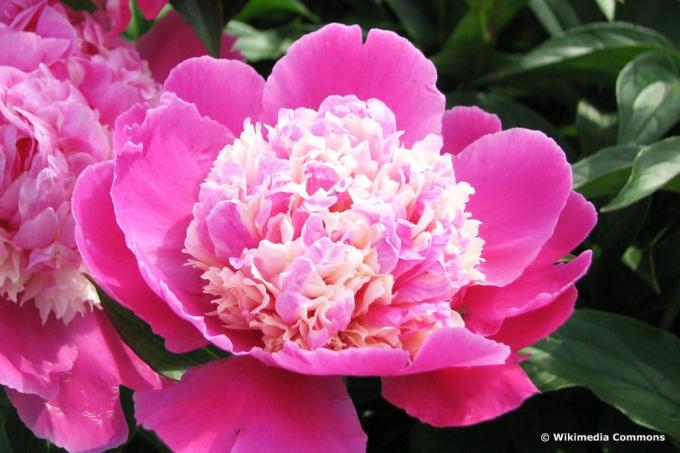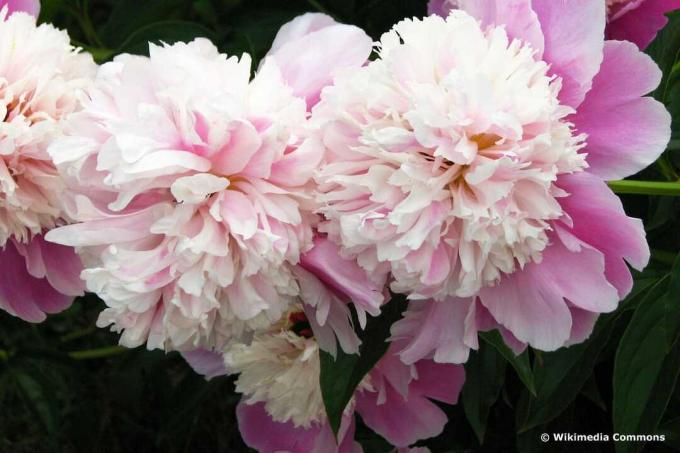
table of contents
- Location
- floor
- plants
- to water
- Fertilize
- Cut
- Multiply
- Diseases and pests
Profile and care information open +conclude -
- Flower color
- pink, green
- Location
- Partial shade, shady, sunny
- Heyday
- May June
- Growth habit
- upright, perennial, clump-forming
- height
- up to 100 centimeters high
- Soil type
- loamy
- Soil moisture
- moderately moist
- PH value
- neutral, slightly acidic
- Limescale tolerance
- Calcium tolerant
- humus
- rich in humus
- Poisonous
- Yes
- Plant families
- Peony Family, Paeoniaceae
- Plant species
- Butterfly plants, Perennials
- Garden style
- Rose garden, perennial garden
Peonies have been cultivated by humans for over 2,000 years and are not only a feast for the eyes, but also seduce the nose with their characteristic aroma. The variety Paeonia lactiflora 'Cora Stubbs' presents itself as a Chinese peony with the expansive Japanese flower shape and a pleasant height. Similar to other peonies, care is quite simple, as the plant is robust and can live for more than 50 years.
Location
The Chinese peony is happy about a location with the following characteristics:
- Light requirement: full sun
- warm
- enough space to grow: at least a meter
- should be the final location of the plant

Note: Do not move the plant after you have planted it. They get used to their location very quickly and could react negatively to repositioning and fail an entire flower.
floor
Paeonia lactiflora also does not have high demands on the soil:
- fresh
- humic-loamy
- sandy
- well permeable
- ventilated
- sheltered from the wind
Above all, good drainage is important here so that the plant does not drown, which is especially necessary over winter or in early spring.
plants
Specimens are planted in autumn, just before winter sets in, so that they can easily start sprouting in the next year. Give the plant enough space and loosen the soil well before planting the Chinese peony in the soil. Now cover the roots up to three buds. From these shoot more shoots in the spring. Now water extensively to moisten the soil sufficiently.

Tip: You can cut off one of the numerous flowers in midsummer and place it in the vase. The scent is then still audible and the pink color looks extremely good in the apartment.
to water
A peony is watered as needed, which means watering more frequently during longer periods of drought. Look at the soil around the plant to decide if you need to water. If the floor is dry, it does not have to be watered yet. But if it has dried out, you should pour more. The roots do not suffer from drought, but be careful not to over water. The rule here is: less is more.
Fertilize
You only need to fertilize the Paeonia lactiflora if you do not have a nutrient-rich soil that can provide the peony with its necessary nutrients. It is best to work fresh compost and an organic fertilizer such as horn shavings into the soil of the milk white peony. This happens in spring and provides the plant with enough food for the whole year. She doesn't need more, which is what makes her so popular with many gardeners.
Cut
The Chinese peony does not need pruning, but should be pruned in autumn. For this, use clean secateurs and cut all the shoots back to the first bud. Also remove the leaves that would rob the plant of energy over the winter.
Overwinter
The plant does not need winter protection.

Multiply
The Cora Stubbs can easily be propagated in autumn by dividing. To do this, proceed as follows:
- carefully dig up the plant and expose the rhizomes
- rinse the rhizome with water
- prepare a clean, sharp knife
- Now cut off the pieces, leaving three buds on each shoot, otherwise the plant will not be able to sprout
- plant the pieces, but not too deep, otherwise the Chinese peony will be blooming
Diseases and pests
This variety is an extremely robust specimen that is hardly susceptible to disease. However, even this variety is not armed against the peony botrytis (peony gray mold), which can attack the roots if there is insufficient air circulation and waterlogging. Appropriate countermeasures must then be taken so that the plant does not perish.



